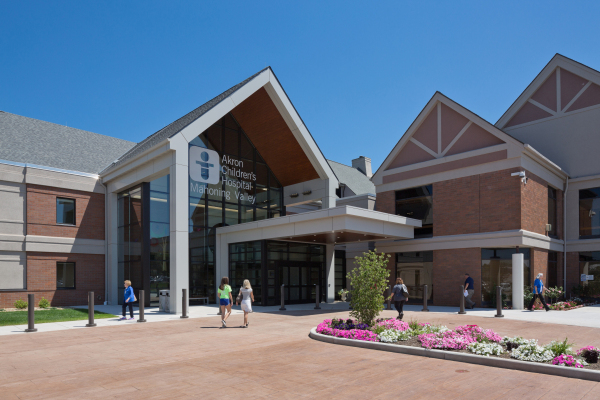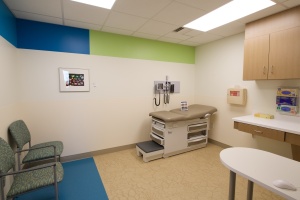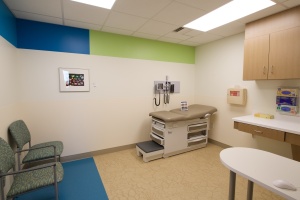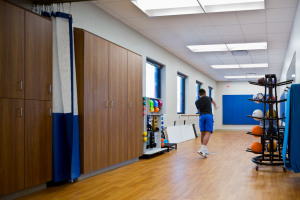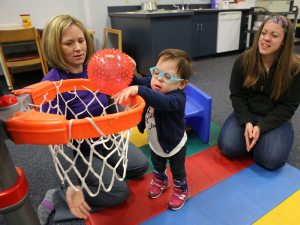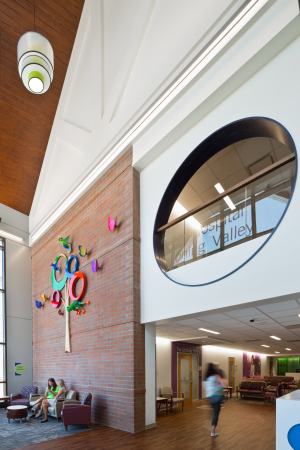New leadership meets new challenges at Akron Children’s Hospital
March 19, 2021
by Gus Iversen, Editor in Chief
In January, Akron Children’s Hospital named Paul Olivier vice president of Akron Children’s Hospital Mahoning Valley. Healthcare Business News checked in with Olivier to learn more about his background and what attracted him to his current position.
HCB News: Who or what inspired you to follow a career in healthcare?
Paul Olivier: My parents were both in healthcare — my father was a dermatologist and my mother was a nurse — and they both instilled in me a desire to care for others. I had entered college to pursue a business administration degree, but it was my father who suggested I look into hospital administration.
HCB News: You recently joined Akron Children’s Hospital as vice president. What professional experiences have led you to where you are now?
PO: I’ve been fortunate to have a variety of work experiences with increasing responsibilities in different markets across the country. I worked at Children’s National Medical Center in Washington, D.C., before moving to Ohio. Then I worked in a number of leadership roles at the Bon Secours Mercy Health system. I’ve had over 25 years of work experience prior to joining Akron Children’s Hospital and I believe for all of us, each moment accumulates to prepare us for the roles in which we are called to serve.
HCB News: What attracted you to Akron Children’s?
PO: During my time at Mercy, I became familiar with Akron Children’s due to the different collaborative projects the two companies worked on. I had always been impressed with Akron Children’s culture and having worked in pediatric healthcare previously, I certainly had an affinity for that work and those populations we serve. As a resident of Boardman, I was so impressed when Akron Children’s made the commitment to establishing a hospital in the Mahoning Valley. That commitment to this area, which has its fair share of health challenges, was very inspirational.
HCB News: Akron Children’s is a pediatric hospital and you are based at the hospital’s Mahoning Valley campus in Boardman. Can you describe the demographics and patient populations you're serving in the community?
PO: The Mahoning Valley has an interesting dynamic when it comes to its population. Over the years, the trend has been more a decline of population, except for those over age 65. When I moved here 20 years ago, the community health indicators were poor and our poverty levels were high. These characteristics are not surprising given the economic challenges that impacted the area with the decline of the steel and manufacturing industries here. So the population has some significant needs when it comes to healthcare. But the low cost of living, the strong workforce, the location proximity to transportation such as highway, rail and air all create tremendous opportunity for economic growth in the valley. We are starting to see the results of collaborative efforts to improve the economic situation, as well as population health. For example, the growth of additive manufacturing through the Youngstown Business Incubator, the development of electric trucks and batteries in Lordstown, and other innovations are creating jobs here and helping position us for more growth. In healthcare, it’s amazing to see so many health organizations and public entities come together around things like public safety, nutrition, and infant mortality, and the work all parties have done to improve community health is having an impact on our health indicators.
HCB News: So far, what has surprised you or impressed you the most about your new workplace?
PO: I’ve been so impressed with the esprit de corps that is very tangible here. The board and executive leaders at Akron Children’s really have infused our associates with a positive energy focused around caring for children and young adults.
HCB News: Are there any initiatives or special projects you're planning to undertake?
PO: The organization had several plans in the works already when I joined, the most significant being our facility plan for the Boardman campus. There are other initiatives around community health and engagement that I’m looking forward to developing with my colleagues.
HCB News: How is the hospital experiencing the pandemic? What role is the hospital playing?
PO: Just as the pandemic situation has been fluid this past year, Akron Children’s has adjusted to meet the needs of our patients. Like all area hospitals, we participate in the emergency response protocols and have been running our emergency command center regularly to deal with the challenges of the pandemic. Throughout the pandemic, we’ve worked with area hospitals to ensure access to healthcare, even if that means an influx of COVID-19 patients. We’ve adjusted our staffing and retrained our staff to care for adult patients if need be. By doing so, we can help partner hospitals handle overcapacity issues related to COVID-19.
While COVID-19 primarily affects adults, it also impacts children, and we’re starting to see the effects on their emotional and mental health. Akron Children’s will continue to serve as the leader for healthcare for children and young adults as we continue to treat COVID-19 and whatever variants and side effects may arise.
HCB News: Do you see healthcare delivery permanently changing in any fundamental ways due to the pandemic?
PO: Yes, in three main areas. The pandemic has accelerated the use of telehealth services and that has improved access. Secondly, we have learned a lot about the disease and how to combat it, and that will lead to further innovations to fight other diseases (for example, flu incidence is significantly down this year due to mask wearing and increased hand hygiene). The public’s awareness of the role they play in disease transmission has been a positive outcome of the pandemic. Finally, this past year has shown us where we must collaborate, particularly with community leaders and legislators, on where to improve our response to such public health crises.
HCB News: From a wide-angle perspective, healthcare continues to push away from fee-for-service and toward value-based care. Are you seeing those efforts manifest in any specific ways?
PO: Yes, as healthcare providers take on more risk for payments in value-based care, they are using advancements in data to better understand their patients’ needs, as well as factors in their social setting (social determinants of health), in order to provide the appropriate resources in a timelier manner. Care coordination, disease prevention programs and telehealth are examples of efforts to improve health management for patients to keep them healthy; and when they need services, get them to the appropriate venue. The intent is to create more value for the care the patient is receiving.
HCB News: Who or what inspired you to follow a career in healthcare?
Paul Olivier: My parents were both in healthcare — my father was a dermatologist and my mother was a nurse — and they both instilled in me a desire to care for others. I had entered college to pursue a business administration degree, but it was my father who suggested I look into hospital administration.
With two hospital campuses, including this one in Boardman, Ohio, Akron Children's is making it easier for today's busy families to find the high-quality care they need.
PO: I’ve been fortunate to have a variety of work experiences with increasing responsibilities in different markets across the country. I worked at Children’s National Medical Center in Washington, D.C., before moving to Ohio. Then I worked in a number of leadership roles at the Bon Secours Mercy Health system. I’ve had over 25 years of work experience prior to joining Akron Children’s Hospital and I believe for all of us, each moment accumulates to prepare us for the roles in which we are called to serve.
HCB News: What attracted you to Akron Children’s?
PO: During my time at Mercy, I became familiar with Akron Children’s due to the different collaborative projects the two companies worked on. I had always been impressed with Akron Children’s culture and having worked in pediatric healthcare previously, I certainly had an affinity for that work and those populations we serve. As a resident of Boardman, I was so impressed when Akron Children’s made the commitment to establishing a hospital in the Mahoning Valley. That commitment to this area, which has its fair share of health challenges, was very inspirational.
Use of bright colors and children's artwork help to make Akron Children's spaces more inviting to families.
PO: The Mahoning Valley has an interesting dynamic when it comes to its population. Over the years, the trend has been more a decline of population, except for those over age 65. When I moved here 20 years ago, the community health indicators were poor and our poverty levels were high. These characteristics are not surprising given the economic challenges that impacted the area with the decline of the steel and manufacturing industries here. So the population has some significant needs when it comes to healthcare. But the low cost of living, the strong workforce, the location proximity to transportation such as highway, rail and air all create tremendous opportunity for economic growth in the valley. We are starting to see the results of collaborative efforts to improve the economic situation, as well as population health. For example, the growth of additive manufacturing through the Youngstown Business Incubator, the development of electric trucks and batteries in Lordstown, and other innovations are creating jobs here and helping position us for more growth. In healthcare, it’s amazing to see so many health organizations and public entities come together around things like public safety, nutrition, and infant mortality, and the work all parties have done to improve community health is having an impact on our health indicators.
Use of bright colors and children's artwork help to make Akron Children's spaces more inviting to families.
PO: I’ve been so impressed with the esprit de corps that is very tangible here. The board and executive leaders at Akron Children’s really have infused our associates with a positive energy focused around caring for children and young adults.
The hospital treats patients up to 21 years of age, including student athletes in departments like Sports Rehab.
PO: The organization had several plans in the works already when I joined, the most significant being our facility plan for the Boardman campus. There are other initiatives around community health and engagement that I’m looking forward to developing with my colleagues.
HCB News: How is the hospital experiencing the pandemic? What role is the hospital playing?
PO: Just as the pandemic situation has been fluid this past year, Akron Children’s has adjusted to meet the needs of our patients. Like all area hospitals, we participate in the emergency response protocols and have been running our emergency command center regularly to deal with the challenges of the pandemic. Throughout the pandemic, we’ve worked with area hospitals to ensure access to healthcare, even if that means an influx of COVID-19 patients. We’ve adjusted our staffing and retrained our staff to care for adult patients if need be. By doing so, we can help partner hospitals handle overcapacity issues related to COVID-19.
While COVID-19 primarily affects adults, it also impacts children, and we’re starting to see the effects on their emotional and mental health. Akron Children’s will continue to serve as the leader for healthcare for children and young adults as we continue to treat COVID-19 and whatever variants and side effects may arise.
HCB News: Do you see healthcare delivery permanently changing in any fundamental ways due to the pandemic?
PO: Yes, in three main areas. The pandemic has accelerated the use of telehealth services and that has improved access. Secondly, we have learned a lot about the disease and how to combat it, and that will lead to further innovations to fight other diseases (for example, flu incidence is significantly down this year due to mask wearing and increased hand hygiene). The public’s awareness of the role they play in disease transmission has been a positive outcome of the pandemic. Finally, this past year has shown us where we must collaborate, particularly with community leaders and legislators, on where to improve our response to such public health crises.
Akron Children's designs all of its spaces through the eyes of a child, including the entry to its Boardman campus.
PO: Yes, as healthcare providers take on more risk for payments in value-based care, they are using advancements in data to better understand their patients’ needs, as well as factors in their social setting (social determinants of health), in order to provide the appropriate resources in a timelier manner. Care coordination, disease prevention programs and telehealth are examples of efforts to improve health management for patients to keep them healthy; and when they need services, get them to the appropriate venue. The intent is to create more value for the care the patient is receiving.

